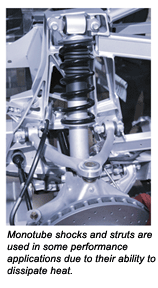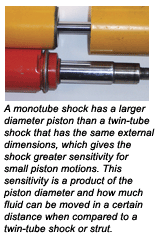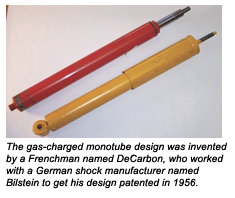From the outside, most shock absorbers and struts look pretty much alike: a round steel tube that telescopes up and down with bushings or fittings on both ends. But inside there can be significant design differences that affect not only the ride control characteristics and performance of the damper, but also its cost. So let’s take a closer look at the “monotube” design.
In a conventional twin-tube shock absorber, the inner piston chamber is surrounded by an outer tube that acts as the fluid reservoir. As the shock pumps up and down, the action of the piston forces the hydraulic oil inside to flow back and forth through valving in the bottom of the shock into the outer fluid reservoir. In a monotube shock, there is no outer fluid reservoir. All the fluid remains in the piston chamber and a floating piston separates the fluid from a high pressure gas charge.
As the piston moves down, the fluid pushes against the floating piston and compresses the gas charge underneath it. The gas is actually nitrogen (air with oxygen and moisture removed). This creates a sort of “air spring” effect that keeps the fluid under constant pressure to reduce foaming as it flows back and forth through the orifices and valves in the piston.
For the monotube design to work, the gas pressure under the floating piston in the bottom of the shock must be quite high: 360 psi in the original Bilstein design, though some other manufacturers use pressures in the 260 psi range today. This also requires a good seal on the floating piston and a highly polished surface inside the piston tube — both of which increase the manufacturing cost of the shock.
When the monotube design was invented back in the 1950s, it was a revolutionary breakthrough in shock absorber technology. The floating piston and high pressure gas charge solved the foaming problem that had plagued conventional hydraulic shocks for a long time. When the fluid foams, the tiny bubbles offer less resistance to the motions of the piston causing the dampening characteristics of the shock to fade. This allows more wheel bounce and suspension motion and hurts handling. So when the first monotube gas charged shocks came out, it made a dramatic improvement in handling control.

The gas charged monotube design was invented by a Frenchman named DeCarbon, who worked with a German shock manufacturer names Bilstein to get his design patented in 1956. Two years later, Mercedes became the first auto maker to install monotube shocks as original equipment on some of their cars.
Because the gas charged monotube design was protected by patents, Bilstein had a monopoly on the technology up until 1971 when their patents expired. Other shock manufacturers, such as Koni, KYB, Tokiko, Monroe and Sachs, began producing monotube shocks of their own, and also added gas charging to many conventional twin-tube shocks.
Monotube shocks were widely used in racing in the 1960s and 1970s, and found their way into NASCAR in the 1980s. Since then, monotube shocks have also been used as original equipment on a variety of cars including Mercedes, Audi, Porsche, BMW, Saab and Volvo, 1993 and newer Camaro and Firebird, late-model Corvettes, and even some pickup trucks.
ADVANTAGES
In addition to reducing fluid foaming for better ride control (which is the gas-charged monotube shocks main advantage), the design has additional advantages over a conventional twin-tube shock:
The monotube shock provides better heat dissipation and cooling than a twin-tube shock. There is no outer tube or fluid reservoir to inhibit heat flow, so the monotube shock runs cooler and delivers more consistent ride control.
A monotube shock is lighter than a twin-tube shock that has the same external diameter. This reduces unsprung weight and allows the wheels and tires to follow the road more closely.
A monotube shock can be mounted in any position (right side up, upside down or even sideways) and still work. A twin-tube shock uses gravity to drain the fluid down through the valving in the bottom, and to maintain the gas charge in the outer reservoir. But a monotube has a floating piston and no reservoir, so the orientation of the shock does not matter. On racing applications, such as Formula One or Indy Cars, the shocks can be mounted sideways inside the body to reduce drag for better aerodynamics.
A monotube shock has a larger diameter piston than a twin-tube shock that has the same external dimensions, which gives the shock greater sensitivity for small piston motions.
Monotube shocks are used for may coil-over applications because of their compact design. Many of these applications also feature adjustable valving so the ride characteristics can be fine tuned or changed depending on how the vehicle is being driven.

REPLACEMENT MARKET
Like any type of shock absorber, a monotube shock won’t last forever. Over time, the piston seals can wear as can the shaft seal at the top of the shock. Fluid leaks and loss of the gas charge will reduce the shock’s ability to control the suspension, so eventually the shocks will have to be replaced.
According to market research, 86% of vehicles that end up in a salvage yard still have their original shocks or struts in place. Nobody ever replaced the shocks or struts — even though they probably needed it. The point here is that many vehicles are driving around with shocks or struts that are weak and should be replaced to restore like-new ride control and handling. Monroe currently recommend replacing the original equipment shocks and struts every 50,000 miles. If more motorists would do that, the shock/strut aftermarket could grow from its current $800 million a year in sales to who knows what? Yet the replacement market for shocks and struts remains flat.
DIAGNOSIS
A test ride is probably the best way to detect weak shocks or struts that need to be replaced, but a traditional bounce test is still a quick way to check for weak dampers, too. If the suspension bounces more than once after rocking and releasing the bumper, chances are the original shocks or struts are worn and should be replaced to restore safe handling.
A visual inspection of the shocks and struts should always be made anytime a vehicle has a tire wear problem, or you are doing an alignment, brake job or other undercar repairs or service work. Look for obvious signs of trouble such as fluid leaks, severe corrosion, broken or damaged mounts, signs of suspension bottoming, or cupped wear on any of the tires.
If you discover a shock or strut that has a problem or is getting weak, bring it to your customer’s attention and offer to replace their old shocks or struts with new ones. You should also ask them about their driving needs, what kind of ride they prefer, then discuss any possible suspension upgrades that would be a benefit to them. You might discuss the advantages of upgrading to some type of performance shock (gas-charged monotube) or adjustable dampers if that type of product would be of interest.











